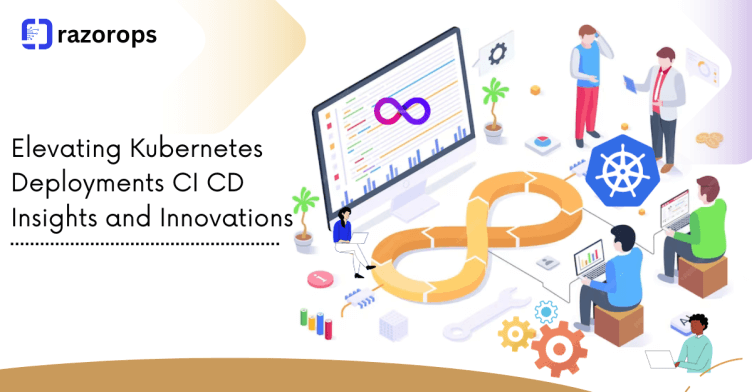
Elevating Kubernetes Deployments CICD Insights and Innovations
Kubernetes has revolutionized container orchestration and is now the de facto choice for managing and scaling containerized applications. However, to fully harness the power of Kubernetes, a robust and efficient Continuous Integration and Continuous Deployment (CI/CD) pipeline is essential. In this blog, we will explore some key insights and innovations to elevate Kubernetes deployments through advanced CI/CD practices.
CI/CD Best Practices for Kubernetes
To elevate your Kubernetes deployments, consider these CI/CD best practices:
Infrastructure as Code (IaC): Implement Infrastructure as Code using tools like Terraform or AWS CloudFormation. This ensures that your infrastructure is version-controlled and easily reproducible.
Immutable Deployments: Use immutable deployment strategies where you replace existing pods with new ones instead of updating them in-place. This minimizes risk and allows for easy rollbacks.
GitOps: Adopt GitOps practices, where your entire Kubernetes configuration is stored in a Git repository. Tools like ArgoCD can automatically synchronize your cluster with your Git repository, ensuring consistent, declarative configurations.
Testing Automation: Implement automated testing in your CI/CD pipeline, including unit, integration, and end-to-end tests. This helps catch issues early in the development process.
Artifact Management: Use container registries and artifact management solutions to store and version your application images. This ensures that you can roll back to any previous version if needed.
Emerging CI/CD Innovations for Kubernetes
As technology advances, new CI/CD innovations continue to shape the Kubernetes landscape:
GitOps with Progressive Delivery: Progressive Delivery extends GitOps principles by introducing feature flags and canary releases. Tools like Flagger enable automated canary deployments with Prometheus metrics-based analysis.
Kubernetes Operators: Operators are Kubernetes extensions that provide automation for application-specific tasks. Leveraging operators in your CI/CD pipeline can simplify complex application deployments.
Serverless CI/CD: Serverless CI/CD solutions, like AWS CodePipeline or Google Cloud Build, eliminate the need to manage CI/CD server infrastructure, making it easier to scale and reducing operational overhead.
Machine Learning in CI/CD: Integrating machine learning models into CI/CD pipelines is becoming more common. You can automate model training, testing, and deployment using tools like Kubeflow.
Observability and AIOps: Implementing observability and AIOps solutions into your CI/CD pipeline allows for proactive issue detection, self-healing, and performance optimization.
Immutable Infrastructure:
Traditional deployment pipelines may modify running containers in-place, leading to configuration drift and inconsistencies. Kubernetes favors the “immutable infrastructure” paradigm, where deployments are built from scratch for each new version. By implementing immutable infrastructure in your CI/CD pipeline, you ensure that each deployment is a pristine copy of the desired state, enhancing reliability and reproducibility.
GitOps and Declarative Configuration:
GitOps is an innovative approach where your Kubernetes configurations are stored in a Git repository. Any changes to your infrastructure are made through Git commits, ensuring transparency and version control. Tools like ArgoCD and Flux make GitOps a reality, allowing you to declaratively manage your cluster configurations and applications.
Automated Testing:
Implement comprehensive automated testing to catch issues early in the CI/CD pipeline. Unit tests, integration tests, security scans, and performance tests should be an integral part of your CI/CD workflow. Kubernetes-native testing tools like Sonobuoy can help ensure the quality of your deployments.
Canary Deployments and Blue-Green Deployments:
Canary deployments involve rolling out a new version to a small subset of users to validate its performance and stability. Blue-green deployments entail switching traffic between two identical environments, allowing easy rollback in case of issues. These strategies minimize risk and ensure a smooth transition to new releases.
Custom Operators:
Kubernetes Operators extend the capabilities of Kubernetes by automating complex operational tasks. Building custom operators for your application allows you to define and manage custom resources specific to your application, streamlining deployment and management.
Continuous Monitoring and Observability:
Incorporate observability tools like Prometheus, Grafana, and Jaeger to gain insights into the health and performance of your Kubernetes applications. Real-time monitoring and alerting help you detect and address issues promptly, reducing downtime.
Security Scanning and Policy Enforcement:
Security should be a top priority in Kubernetes deployments. Implement security scans to identify vulnerabilities in your container images. Enforce network policies and use tools like PodSecurityPolicies to ensure that only trusted and authorized containers run in your cluster.
Cost Optimization:
Kubernetes deployments can be cost-intensive if not managed efficiently. Tools like KEDA and Horizontal Pod Autoscaling can automatically scale resources based on demand, helping you optimize your infrastructure costs.
Multi-Cluster and Hybrid Cloud Deployments:
As organizations expand, they often require multi-cluster or hybrid cloud deployments. Kubernetes Federation and multi-cluster management platforms like Rancher can help manage and synchronize configurations across clusters, ensuring consistent deployments.
Serverless Integration:
Kubernetes and serverless technologies can work together to provide the best of both worlds. Knative and AWS Fargate are examples of serverless platforms that seamlessly integrate with Kubernetes, allowing for efficient, event-driven scaling.
Best Practices for Elevated Kubernetes Deployments
Define a Standardized Pipeline
Create a standardized CI/CD pipeline for your Kubernetes applications, ensuring that it encompasses all necessary stages from code commit to production deployment.
Monitor and Optimize
Implement monitoring and observability throughout your CI/CD pipeline to detect issues early and continuously optimize the process for efficiency and reliability.
Security as Code
Incorporate security scanning tools into your CI/CD pipeline to detect vulnerabilities early in the development process and ensure secure deployments.
Tutorials & Guides
Kubernetes Production Patterns
Top Reading Recommendations
Upcoming Events
CNCF On demand webinar: Securing Kubernetes runtime with KubeArmo
October 27 – 12:30 PM (PST)
DevOps Jobs
Google - Check out all the jobs
here
Accenture -Check out all the jobs here
Infosys -Check out all the jobs here
Microsoft -Check out all the jobs
here

PS- We publish this newsletters every week, Subscribe and share with your friends. We hope this newsletter has provided valuable information. Follow RazorOps Linkedin Page Razorops, Inc.





